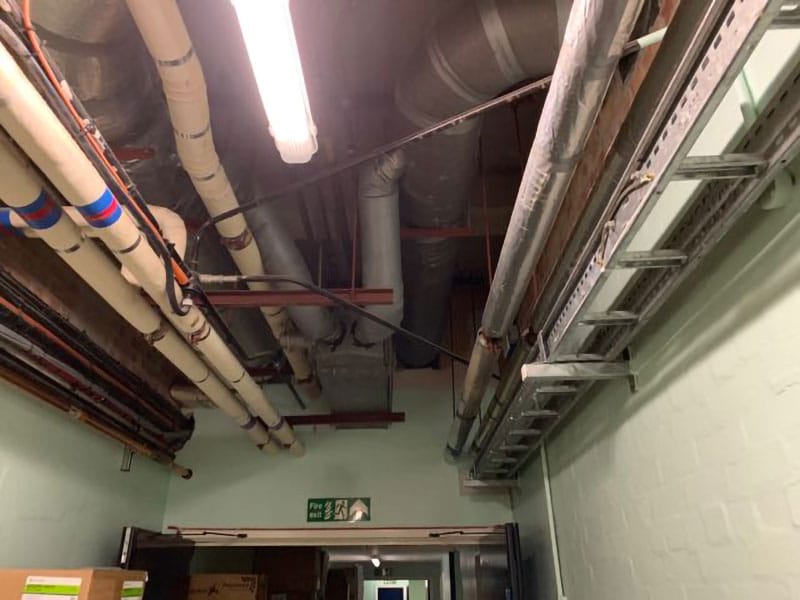Asbestos Priority Risk Assessment Explained
If you are seeking to take all the necessary steps for managing asbestos on a non-domestic site for which you are responsible, you will need to know what an asbestos priority risk assessment is – including how it differs from the material risk assessment.
What is an asbestos priority risk assessment?
The Control of Asbestos Regulations 2012, also known as CAR 2012, put in place a “duty to manage” asbestos on non-domestic premises. The person who has the “duty” – in other words, the “dutyholder” – will be the owner of the given premises, or the person or organisation that has clear responsibility for maintaining or repairing the premises.
What does all of this have to do with the asbestos priority risk assessment? Well, if it is necessary to have an asbestos survey carried out on your site in order to fulfil your regulatory responsibilities under CAR 2012, you will need to make – and keep up to date – a record of the location and condition of asbestos-containing materials (ACMs) on your premises.
In other words, you will need to create an “asbestos register”, which is a document that shows the results of an asbestos survey on a building. The asbestos register for your own buildings will need to detail where asbestos is located on your premises, or where asbestos might be present.
As part of your process of creating the asbestos register for your premises, for each entry in the document, you will need to set a material score and a priority score.
It is important to appreciate that the material risk assessment is a different thing to the priority risk assessment. While a material assessment considers the material itself and the risk it could therefore pose to those nearby, a priority risk assessment accounts for other factors that could damage the asbestos material, rather than just the material itself.
Imagine, for example, a situation where your material assessment concludes that a particular material is low risk. But what if that material is in a part of your premises where it could be prone to sustaining damage? In that case, a priority risk assessment could conclude the material to be high risk. This will change the overall risk picture for that particular item.
When do I need an asbestos priority risk assessment?
As set out above, an asbestos priority risk assessment is required alongside a material risk assessment in accordance with CAR 2012.
An asbestos management survey is especially likely to be required for your premises if the buildings on your site were constructed prior to 2000, given that the use of asbestos in the UK was only banned in 1999. If your premises do indeed require an asbestos survey, you will also need to put together an asbestos register to show the results of that survey.
This means that you will need to decide on a material score and a priority score for every entry in your asbestos register. An asbestos surveyor will provide the material assessment report, and it will be your responsibility – as the dutyholder – to turn that into a priority report.
The priority risk assessment will help you, as the dutyholder, to determine the likely risk of someone being exposed to asbestos fibres from the ACMs on your site. As the term “priority” suggests, this process will also help you determine which items will require the most urgent action in order to minimise the risk they pose to people using your site.
How to determine the priorities for action
The Health and Safety Executive (HSE) has a scoring system for both the material assessment and the priority assessment for dutyholders managing asbestos on their premises. It is important to follow this system for every entry in your asbestos register, as it will enable you to determine which work you will need to carry out first in order to manage the asbestos risk in your buildings.
The items on your asbestos register that have the highest priority scores are those that you will need to pay attention to most urgently. If multiple items have the same priority score, you should prioritise based on which of those items have the highest material scores.
The priority risk assessment takes into account four factors:
- Occupant activity, which refers to the type of activities carried out in the given area
- Likelihood of disturbance – in other words, how easy it could be to damage the given material on the basis of its location, accessibility, and size
- Human exposure potential – the scale of how many people could be at risk of breathing in or ingesting asbestos fibres, how often, and for how long
- Maintenance activity – the types of maintenance activities that are likely to take place within the area where the asbestos is present, and how frequently those activities occur. This factor, then, is concerned with the likelihood of routine maintenance works causing damage to the ACMs.
Below, we have outlined the HSE’s scoring system for asbestos priority risk assessments. To come up with a total priority score, you will need to add the normal occupant activity score to the three average scores from the likelihood of disturbance, human exposure potential, and maintenance activity sections. You can then add your total priority score to your material score to get a total overall score.
Normal occupant activity
Main type of activity in area
- Score 0: Rare disturbance activity (e.g., a little-used storeroom)
- Score 1: Low disturbance activities (e.g., office-type activity)
- Score 2: Periodic disturbance (e.g., industrial or vehicular activity which could lead to contact with ACMs)
- Score 3: High levels of disturbance (e.g., fire door with asbestos insulating board sheet in constant use)
Likelihood of disturbance
Location
- Score 0: Outdoors
- Score 1: Large rooms, warehouse or well-ventilated areas
- Score 2: Rooms up to 100 square metres in area
- Score 3: Confined or restricted areas
Accessibility
- Score 0: Usually inaccessible or unlikely to be disturbed
- Score 1: Occasionally likely to be disturbed
- Score 2: Easily disturbed
- Score 3: Routinely disturbed
Extent/amount
- Score 0: Small amounts or single items (e.g., gaskets, strings)
- Score 1: Less than 10 square metres area, or 10-metre pipe run
- Score 2: 10 to 50 square metres area, or 10 to 50 metres pipe run
- Score 3: More than 50 square metres, or 50 metres pipe run
Work out the average scores for location, accessibility, and extent/amount; the maximum score is 3.
Human exposure potential
Number of occupants
- Score 0: None
- Score 1: 1 to 3
- Score 2: 4 to 10
- Score 3: More than 10
Frequency of use of area
- Score 0: Infrequent
- Score 1: Monthly
- Score 2: Weekly
- Score 3: Daily
Average time area is in use
- Score 0: Less than one hour
- Score 1: One to less than three hours
- Score 2: Three to less than six hours
- Score 3: More than six hours
Work out the average scores for number of occupants, frequency of use, and average time area is in use; the maximum score is 3.
Maintenance activity
Type of maintenance activity
- Score 0: Minor disturbance (e.g., possibility of contact when gaining access)
- Score 1: Low disturbance (e.g., changing lightbulbs in asbestos insulating board ceiling tiles)
- Score 2: Medium disturbance (e.g., lifting one or two asbestos insulating board ceiling tiles to access a valve)
- Score 3: High levels of disturbance (e.g., removing a number of asbestos insulating board ceiling tiles to replace a valve or for recabling, or leak repair)
Frequency of maintenance activity
- Score 0: Unlikely – almost never
- Score 1: Less than once a year
- Score 2: Less than once a month
- Score 3: More often than once a month
Work out the average scores for type of maintenance activity and frequency of maintenance activity; the maximum score is 3.
Calculating the priority risk assessment score
To reiterate what we stated above, when you add the occupant activity score to the three average scores for the likelihood of disturbance, human exposure potential, and maintenance activity, you will have a total priority assessment score out of 12. Combining this with the material assessment score will result in a total overall score.
Below is a table that will help assess the priority risk level based on the results of your combined material assessment and priority risk assessments.
| Risk of Fibre Release | Score | Frequency of Check |
|---|---|---|
| High | > 18 | Urgent Action / Remove |
| Medium | 14 - 17 | Encapsulate / Seal & Monitor |
| Low | 9 - 13 | Monitor Six to Twelve Monthly |
| Minor | 1 - 8 | Monitor Annually |
From here, you will be able to make decisions on how you will deal with the different types of asbestos materials that may be present on your site. This will entail you putting together an asbestos management plan, which will provide crucial information on your plans to work on any ACMs on your premises.
Our team at Oracle Solutions can help ensure you fulfil all your responsibilities in relation to any asbestos materials in your non-domestic premises. Simply call us or send us an email, to learn more about our wide-ranging asbestos consultancy services, and to request a fast and free quote.

Written by Mark Carter
Mark Carter is a renowned expert in asbestos management, offering clients vital guidance on compliance and safety. His expertise is invaluable for navigating asbestos regulations, ensuring both safety and legal adherence. Mark's role is central in providing effective asbestos-related solutions, helping clients achieve their business objectives with an emphasis on regulatory compliance and safety in asbestos management.

